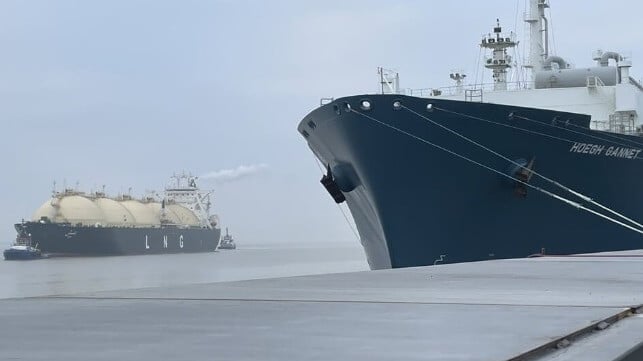Germany’s Third LNG Import Terminal Receives First LNG Tanker

Germany’s third LNG import terminal is moving into the commissioning phase in record time since the start of the project. The first LNG shipment arrived at the terminal located in Brunsbüttel at the mouth of the Elbe River in central Germany. The other terminals are located to the west in Wilhelmshaven and in Eastern Germany in Lubmin.
German energy company RWE, which is overseeing the project for the federal government points out the speed at which the partners have been able to develop the site. The government reached an agreement for the terminal in May 2022 and by October construction had begun. The FSRU unit arrived in mid-January and now the first test shipment of LNG arrived. Work needs to be completed on some of the shore infrastructure followed by testing but they expect to start feeding gas before the end of February. In March regular operations will begin.
The Liberian-registered LNG tanker Ish operated by Adnoc (Abu Dhabi National Oil Company) docked at the Elbehafen LNG terminal earlier today, February 14. The 71,500 dwt ton vessel built in 1995 has a capacity of 137,500 cubic meters of liquid gas. She was loaded at Adnoc’s terminal on Das island departing on January 11.
The gas carrier was docked alongside the Hoegh Gannet FSRU which is operating under a 10-year charter to the German government. The charter was completed on January 19 and the vessel arrived for the first time the following day at the terminal for initial tests on the dock and shore connections. Before the trip to Germany, the FSRU was loaded with a partial cargo of LNG in Spain to be used in the initial tests.
“Floating LNG terminals enable the import of gas and thus strengthen Germany’s security of supply. The strong energy dependence of our country on Russian pipeline gas will end with the deployment of the special vessels,” said Markus Krebber, CEO of RWE. “The high speed at which the project in Brunsbüttel was jointly driven forward by all involved parties sets standards for the further modernization of our energy supply. This will also be necessary to ensure that Germany as an industrial location becomes climate-neutral as soon as possible.”
The Elbehafen LNG terminal joins Wilhelmshaven which commissioned the first of the five government-chartered FSRU units in December. The second terminal is being privately operated by Deutsche Regas and began operations in mid-January also after several weeks of testing.
Plans are already underway to further expand the operation and use it as a basis for the imports of alternative fuels. The FSRU unit in Elbehafen will be relocated to a permanent location late in 2023 at a new berth west of the current one. It will be operated by Brunsbüttel Ports while the government’s Deutsche Energy Terminal company plans to work with RWE to develop the multi-function LNG terminal as well as a facility for the import of green ammonia. From 2026, RWE plans to begin importing around 300,000 tons of green ammonia and today they announced a distribution plan with logistics company VTG to use rail transport for the distribution of the ammonia fuel into Germany and neighboring countries.
In addition to adding a second FSRU at Wilhelmshaven, the government also plans to add another terminal in 2023 on the Elbe closer to Hamburg at Stade. Several studies are underway to expand the operation in Lubmin, including the addition of a second FSRU unit. RWE is proposing to add a new feed pipeline into Lubmin as well as a government effort to added additional terminal space at nearby Rugen which would have more direct access. The terminal in Lubmin is currently limited by the small port, which requires the larger LNG carriers to anchor offshore and transfer the gas first to shuttle tankers to reach the FSRU.
German officials are confident that these terminals will make up for the former Russian pipeline supplies and provide greater energy independence. Longer-term by 2026 and 2027 they anticipate that Wilhelmshaven, Brunsbüttel and Stade would all be used for the imports of ammonia and hydrogen fuels.
